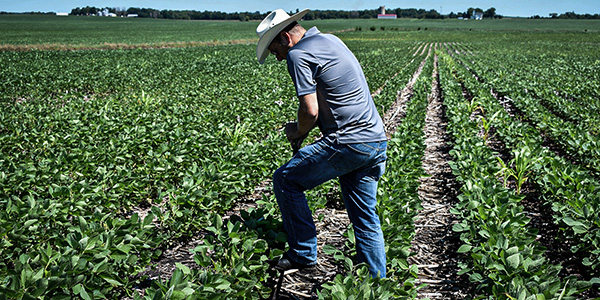AGRONOMICSUPPORT
YOU CAN TAKETO THE FIELD
Results of Early Planted Soybean Studies
Over the last three years I have been working with growers with a large focus on increasing soybean yields. Every year we do planting date studies pushing soybeans earlier and earlier each year if the weather is fit, along with soybean population studies. Five years ago I would have never thought I would see 100+ bushel soybeans in the near future, and I was wrong. I have seen 100+ bushel soybeans the last few years and there are a few tips to increasing your soybean yields and results from the testing we have done so far. Some of these tips may seem basic but each one can impact soybean yields and increase ROI, some more than others.
Soybean Planting Depth and Equipment
First things first, it’s time to stop using the drill to plant soybeans. Drills are great for planting wheat and other small seed crops, but not soybeans. Using a planter, just like in corn, gets better depth control, singulation, population control and proper row spacing. Planting soybeans at the proper depth and population are the biggest gains you’ll get with a planter. Since we’ve been testing earlier planting dates, we have planted soybeans anywhere from three inches to one inch deep, finding the best results at two to two and a half inches deep when planted early. I have seen more uniform emergence and better final stands with less stand loss. Also, soybean genetics have changed to more of a branchy bush style plant from the thin line style of the past. If you’re planting a bush style bean in narrow rows, you can limit the yield potential of the soybeans just the same as planting thin line beans in wider rows.
Soybean Planting Date
Plant soybeans early. I was very skeptical of planting soybeans early at first, but my opinion of this has greatly changed in the last few years. When we first started with early soybean plantings, we started at the first fit day past April 1. The ground was fit but soil temperatures were low. I figured we would have poor stands and it was a waste of time. We then planted the same variety three weeks later at the same population and depth and the results were surprising. This was the first time I saw 100+ bushel soybeans in Ohio. April 3 planted LGC2888RX yielded 101.9 bushels while the April 24 planted LGC2888RX yielded 81.9. That was a 20 bushel increase by planting three weeks earlier.
Last year we decided to plant as early as March 4. To my surprise, we had snow and cold temperatures after planting (but before emergence) and we still had a 90% stand come the first week of May. These soybeans were unfortunately lost in a hard frost on May 15. They survived extremely cold temperatures but were still able to push though with a good stand. This year we have two sets planted: one from mid-March and one from April 1. I’m hoping we don’t have a frost that will wipe them out again this year.
It is a risk with the extremely early planting, but one thing is for sure: soybeans can withstand cold soils much better than corn. Once corn begins to germinate it is a race to the surface and it cannot have a bad day or replanting is very likely. However, I’ve seen soybeans take up to 30+ days to reach the surface and still have good stands. I have been telling many growers to plant soybeans before corn and wait until we have more consistent, warm weather to plant their corn.
Soybean Planting Populations
The next big management tip has been lowering populations. This will be the third year of doing a soybean population study and I am finding that lower populations have paid in both yields and ROI for growers. Michigan State University did a five-year study, and their findings made me want to try it myself. Those 101.9-bushel LGC2888RX were planted in 15 inch rows at 120,000 population. That is about 40,000 below what most growers are currently planting. In our latest population study we planted LGC2888RX in 15 inch rows from 40,000 population up to 140,000. The highest yielding population was 140,000 but only by .3 bushel over 80,000 population. This acutually gave the 80,000 population a ROI of $13.71 higher when figuring seed cost and $10.00 per bushel price. In Michigan State’s trial, the highest ROI on the five-year test was at 100,000 population.
Overall, soybeans compensate very well to lower populations compared to corn. These lower populations also tend to have overall better plant health. With lower number of plants, airflow in the lower canopy is greatly increased which helps to fight against many of our foliar disease and problems such as white mold.
Final Notes For Soybean Planting
Every year I learn more and more and push growers to try things that seem out of the normal. This year I have had many growers planting soybeans earlier and even playing with lower populations. The best way to know what works for you is do some of your own test. Soil types and tillage plays a huge part of populations and planting dates. All the tests I have done are in no till situations so results would surely be different in worked ground. Be sure to ask your Technical Team Agronomist about some of these ideas or any other ideas to help increase soybean yields. Thanks for your support of LG Seeds and have a safe spring.






Technical Team Agronomist